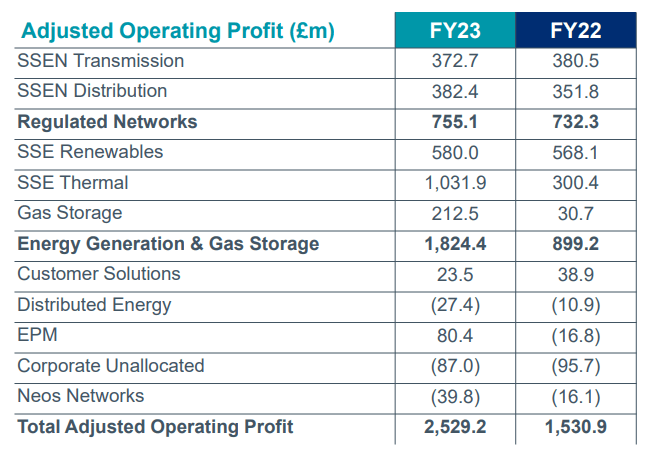The SSE £3 Billion Spending Cut: A Detailed Breakdown

Table of Contents
Reasons Behind the SSE £3 Billion Spending Cut
The SSE £3 billion spending cut wasn't a spur-of-the-moment decision; it's a complex issue stemming from several interconnected factors.
Increased Inflation and Rising Costs
Soaring inflation has significantly impacted the cost of energy projects. The volatile economic climate makes securing financing increasingly challenging. This cost escalation affects every stage of a project.
- Increased material costs: The price of steel, copper, and other essential materials has skyrocketed, driving up project budgets. Estimates suggest a 20-30% increase in material costs in the last year alone.
- Labor shortages: A skills shortage in the construction and engineering sectors has led to increased labor costs and project delays.
- Supply chain disruptions: Global supply chain issues continue to hamper project timelines and increase costs due to delays and shortages of crucial components.
- Rising interest rates: Higher interest rates make borrowing more expensive, increasing the financial burden of large-scale infrastructure projects. The Bank of England's recent interest rate hikes have exacerbated this issue.
Regulatory Uncertainty and Policy Changes
Regulatory uncertainty and shifts in government policies play a crucial role in influencing investment decisions. SSE's investment plans are sensitive to these changes.
- Changes in renewable energy subsidies: Reductions or changes in government subsidies for renewable energy projects can significantly impact their financial viability. SSE's reliance on these subsidies is a key factor affecting its investment strategy.
- Grid connection challenges: Securing grid connections for new renewable energy projects can be a lengthy and complex process, adding to project costs and delays. The UK's grid infrastructure needs significant upgrades to accommodate the influx of renewable energy sources.
- Planning permission delays: Lengthy planning permission processes can significantly delay project timelines, increasing costs and impacting the overall return on investment. Bureaucratic hurdles are a significant challenge for major energy projects.
Focus Shift towards Profitability and Shareholder Value
SSE's decision also reflects a strategic shift towards prioritizing short-term profitability and shareholder value.
- Pressure from investors: Investors are increasingly demanding higher returns, pushing companies to focus on short-term profitability rather than long-term investments.
- Need to improve dividend payouts: Maintaining attractive dividend payouts for shareholders often necessitates a focus on immediate returns.
- Focus on core business operations: SSE may be prioritizing investments in its core business operations to streamline efficiency and enhance profitability. This could mean scaling back on less profitable or riskier ventures.
Impact of the Spending Cut on Renewable Energy Projects
The SSE £3 billion spending cut has significant consequences for renewable energy projects and the UK's commitment to net-zero emissions.
Delayed Renewables Rollout
The reduction in capital expenditure directly translates to delays and potential cancellations of various renewable energy projects.
- Specific projects affected: While SSE hasn't publicly disclosed the specific projects affected, delays are anticipated across wind farm developments and other renewable energy initiatives.
- Potential job losses: Delays and cancellations lead to job losses in construction, engineering, and related sectors. Thousands of jobs could be at risk across the UK.
- Geographical locations: Scotland, known for its significant renewable energy potential, is particularly vulnerable to the negative impacts of this spending cut.
Implications for the UK's Net-Zero Targets
The spending cut jeopardizes the UK's ambition to achieve net-zero emissions by 2050.
- Reduced renewable energy capacity: Delayed or canceled renewable energy projects directly translate to a reduction in renewable energy capacity, hindering progress towards decarbonization.
- Potential impact on energy security: A slower transition to renewable energy could increase the UK's reliance on fossil fuels, compromising energy security and exposing the country to volatile global energy markets.
- Increased reliance on fossil fuels: The shortfall in renewable energy generation may lead to increased reliance on fossil fuels to meet energy demand, undermining the UK's climate change commitments. This will likely impact the UK's carbon reduction targets.
Wider Economic and Social Consequences
The SSE £3 billion spending cut has broader economic and social implications that extend beyond the energy sector.
Job Losses and Regional Impacts
The impact on employment is substantial, particularly in regions heavily reliant on the energy sector.
- Potential job losses in construction, engineering, and related industries: Thousands of jobs in these sectors are at risk due to project delays and cancellations.
- Impacted regions: Regions in Scotland and other areas with significant renewable energy developments will experience disproportionate job losses.
- Estimates: Industry analysts estimate that thousands of jobs could be lost due to this spending cut. This figure could rise if more projects are affected.
Impact on Energy Prices and Consumer Bills
The consequences for consumers are also significant, with potential impacts on energy affordability.
- Potential for increased reliance on more expensive energy sources: Reduced renewable energy capacity could lead to greater reliance on more expensive energy sources like natural gas, potentially driving up electricity prices.
- Potential impact on energy affordability: Higher energy prices could disproportionately affect low-income households, increasing energy poverty.
- Expert opinions: Energy analysts warn that the SSE spending cut could contribute to rising energy bills for consumers, further exacerbating the cost-of-living crisis.
Conclusion
The SSE £3 billion spending cut is a significant development with profound implications for the UK's energy sector and its climate goals. The reasons behind this decision, primarily driven by economic headwinds and a shift towards short-term profitability, highlight the challenges of large-scale energy investments. The resulting delays in renewable energy projects and potential impacts on energy prices underscore the need for a stable policy environment that encourages long-term sustainable energy investments. This decision affects investors, policymakers, and consumers alike. To stay updated on the ongoing impact of the SSE £3 billion spending cut and future developments in the UK energy market, continue to follow reputable news sources and industry analysis. Understanding the complexities of the SSE £3 billion spending cut is crucial for navigating the evolving energy landscape.

Featured Posts
-
 Is Jonathan Groffs Just In Time Role A Tony Awards Front Runner
May 24, 2025
Is Jonathan Groffs Just In Time Role A Tony Awards Front Runner
May 24, 2025 -
 Joy Crookes Unveils Haunting New Track I Know You D Kill Listen Now
May 24, 2025
Joy Crookes Unveils Haunting New Track I Know You D Kill Listen Now
May 24, 2025 -
 Hromadne Prepustanie V Nemecku Dopady Na Ekonomiku A Zamestnancov
May 24, 2025
Hromadne Prepustanie V Nemecku Dopady Na Ekonomiku A Zamestnancov
May 24, 2025 -
 Onlarin Cekim Guecue Seytan Tueyue Olan Burclar
May 24, 2025
Onlarin Cekim Guecue Seytan Tueyue Olan Burclar
May 24, 2025 -
 Avoid Memorial Day Travel Chaos Best And Worst Flight Days In 2025
May 24, 2025
Avoid Memorial Day Travel Chaos Best And Worst Flight Days In 2025
May 24, 2025
